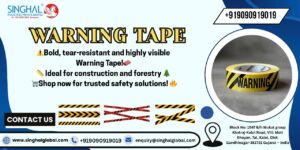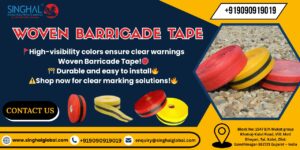When thinking about the integrity and lifespan of your roof, homeowners usually tend to notice the shingles or tiles but tend to ignore a very key Characteristic the roofing underlayment. This vital layering, hidden under your roof’s surface, is a key factor in enlarging the durability and performance of your roof. By understanding its importance and choosing the most appropriate kind for your needs, you can simply enhance the lifespan of your roof and safeguard your home against the elements. There are multiple Roofing underlayment Manufacturers in the country but Singhal Industries is best amongst them.
What is Roofing Underlayment?
Roofing underlayment refers to a product placed directly under shingles, tiles, or metal roof panels. It is an additional layer of protection that keeps the water, snow, and ice from entering the roof deck and, therefore, covering the structure of your home. Underlayment is also a wind barrier, moisture barrier, as well as a sun/UV ray barrier, which over time can degrade your roofing materials.
Apart from being a water-proof layer, underlayment also takes care of the impact of temperature change by acting as an insulator and minimizing heat loss. Through such functions, underlayment supports the general energy efficiency of your home, minimizes the cost of heating and cooling, and maximizes the life cycle of your roof system.
Types of Roofing Underlayment
There are three main categories of Synthetic roofing underlayment: asphalt-saturated felt, synthetic underlayment, and rubberized asphalt underlayment. All possess unique benefits and functionality.
Asphalt-Saturated Felt: Tar paper, or asphalt-saturated felt, has been used as an underlayment for roofs for several decades. It is produced by saturating felt paper with asphalt to render it waterproof. Although it is relatively cheap and easily accessible, it has its drawbacks, such as being prone to tearing and UV exposure wear. Nevertheless, if installed effectively, it can last for many years while offering sufficient protection.
Synthetic Underlayment: Synthetic Underlayment: Synthetic underlayment is a new technology that has gained more popularity since it is more durable, stronger, and more water-resistant than other products.
Rubberized Asphalt Underlayment: Rubberized asphalt underlayment is a more advanced selection for areas with harsh weather situations or greater water intrusion threat. It is manufactured by maintaining a layer of rubberized asphalt to a polyester cloth. It has decent waterproofing and is typically utilized in combination with other underlayment layers to create a multi-layer system. It is especially useful in areas of heavy precipitation, ice damming, or where leaks are a major issue.
Benefits of Quality Roofing Underlayment
The function of quality underlayment is not just to create an extra layer of protection below your roof. It can be the difference maker in the performance and longevity of your roofing system. Let us discuss some of the most important advantages of purchasing high-quality roofing underlayment. Singhal Industries is a leading PP roofing sheets exporters in Ahmedabad.
Enhanced Protection Against Water Damage
One of the fundamental roles of underlayment in roofing is being a waterproof cover. Regardless of having the top-of-the-line shingles or tiles, water may still reach weak points from the best-protected areas on the roof such as valleys, eaves, and around vent penetrations and chimneys. Underlayment retains water from reaching these weak points so that it won’t seep into your attic, roof deck, and ceiling to cause extra harm.
Increased Roof Longevity:
The lifespan of your roof also relies on how well it can resist weather elements, containing wind, rain, snow, and direct sunlight.
Enhanced Ice Dam Prevention:
In areas that have temperatures changing below and above freezing, ice dams are common. Water penetrating the roofing assembly, typically at the eaves, will freeze and build up a dam, preventing water from draining as usual. High-performance underlayment, especially rubberized asphalt formulations, creates an impermeable layer that prevents ice dams from occurring, which eliminates the possibility of water damage and mold growth inside the attic or walls.
Energy Efficiency:
An installed underlayment system can also make your home more energy efficient. Some underlayment products have thermal insulation properties that will help control temperature in your attic and transfer some of the load from your heating and cooling system. This will result in reduced energy expenses for heating and cooling and a more comfortable living environment.
Ease of Installation and Cost-Effectiveness:
Although higher-quality synthetic underlayment and rubberized asphalt products are more expensive upfront, they will at times pay for themselves in the long term through better performance and longevity. They are simpler to install than felt and save labor. Further, since they live longer, fewer repairs and replacements are needed for them.
Better Warranty Safety:
Both underlayment and material roofing companies typically have warranties. Better quality underlayment can include longer warranties from the manufacturer with the sale. Longer warranties can provide homeowners with security and financial assurance if repairs or replacement become obligatory.
Maximizing Roof Lifespan: Installation and Maintenance
In order to make the advantages of good underlayment completely effective, it should be properly installed. Underlayment for roofing must be correctly installed, in a way that it completely covers the roof deck and sealed at edges and seams to avoid water intrusion. Underlayment installation before the main roofing material is also required to provide maximum protection.
Regular maintenance and checks of the underlayment and roof itself are also necessary in prolonging the lifespan of the roof. When checking, look for any signs of wear, tear, or damage, particularly at areas of roof penetrations and areas that are subject to water damage. Once problems are detected, the repair needs to be performed as quickly as possible so that there won’t be more damage.
Conclusion
The best investment you can make in terms of maximum life for your roof and overall security is in first-class roofing underlayment. You may use asphalt-saturated felt, synthetic underlayment, or rubberized asphalt, each providing benefits for particular situations.
Frequently Asked Questions (FAQs)
Can roofing underlayment be used for all types of roofs?
There are three types of underlayment for roofs: Asphalt-saturated felt; Rubberized asphalt; Synthetic.
How does roofing underlayment protect my roof?
It offers a second line of defense against moisture intrusion in the event any water leaks under your shingles.
How long does roofing underlayment last?
Asphalt felt, the most popular form of underlayment, lasts for 20 to 30 years. But in harsh prolonged conditions, its life can be reduced by half.
Can roofing underlayment be installed in all weather conditions?
Synthetic underlayment stays flexible even at sub-zero temperatures. This does not allow for tears and gaps that may weaken the roof during extreme winters.









